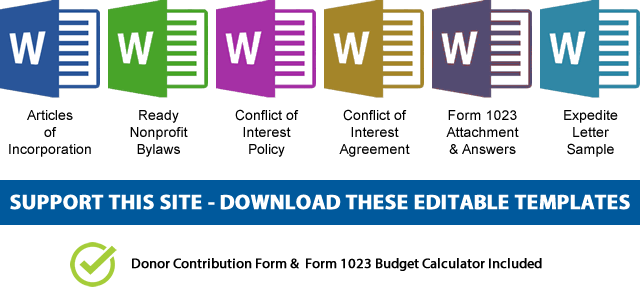Instructions on how to answer the questions on the Form 1023 Schedule D
 Form 1023 Schedule D deals with Supporting organizations which are described in section 509(a)(3). The term “supported organization” refers to an organization that a supporting organization benefits. A supporting organization may support more than one supported organization.
Form 1023 Schedule D deals with Supporting organizations which are described in section 509(a)(3). The term “supported organization” refers to an organization that a supporting organization benefits. A supporting organization may support more than one supported organization.
An organization qualifies as a supporting organization (for purposes of classification under section 509(a)(3)) if: It is organized and at all times thereafter is operated exclusively for the benefit of, to perform the function of, or to carry out the purposes of one or more public charities described in section 509(a)(1) or 509(a)(2).
It should also meets one of three required relationship tests with the supported organization(s); and if It isn’t controlled by “disqualified persons,” directly or indirectly. A supporting organization can also support the charitable purposes of organizations that are exempt under sections 501(c)(4), (5), or (6).
Form 1023 Schedule D Line 1.
List the name, address, and EIN of each organization you support.
Form 1023 Schedule D Line 2.
Answer “Yes,” if each supported organization has a letter from the IRS recognizing it as a public charity under section 509(a)(1) or 509(a)(2). Before you file your application, use Tax Exempt Organization Search on IRS.gov to confirm whether each of your supported organizations is currently recognized as exempt and is classified as a public charity.
Form 1023 Schedule D Line 2a.
Answer “Yes,” if any supported organization you listed on line 1 received a letter from the IRS stating that it’s exempt under sections 501(c)(4), (5), or (6) and meets the public support test under section 509(a)(2). See Pub. 557 for information on the public support test for section 509(a)(2).
If you answer “No,” describe how each organization you support is a public charity under section 509(a)(1) or 509(a)(2). For example, if you support a church or foreign organization that hasn’t received a determination letter recognizing it as a public charity, you should describe how this organization qualifies as a public charity under section 509(a)(1) or 509(a) (2).
Form 1023 Schedule D Line 3. Relationship test.
To qualify under section 509(a)(3), you must show that you meet one of three relationship tests with your supported organization(s). Select the option that best describes your relationship with your supported organization(s).
- Type I (“operated, supervised, or controlled by” relationship; comparable to a parent–subsidiary relationship): A majority of your governing board or officers are elected or appointed by the governing body, members of the governing body, officers acting in their official capacity, or the membership of your supported organization(s).
- Type II (“supervised or controlled in connection with” relationship; comparable to a brother–sister relationship): Your control or management is vested in the same persons who control or manage your supported organization(s).
- Type III (“operated in connection with” relationship; responsive to the needs or demands of, and having significant involvement in the affairs of, the supported organization(s)): One or more of your officers, directors, or trustees are elected or appointed by the officers, directors, trustees, or membership of your supported organization(s); one or more of your officers, directors, trustees, or other important office holders are also members of the governing body of your supported organization(s); or your officers, directors, or trustees maintain a close and continuous working relationship with the officers, directors, or trustees of your supported organization(s).
If you don’t meet one of these three relationship tests, you aren’t described in section 509(a)(3) and should review the other foundation classification options in Part VII, line 1.
Form 1023 Schedule D Line 4.
Describe how your governing board and officers are selected, including where (if applicable) this information is in your governing document, bylaws, or other internal rules and regulations.
Type III organizations must also describe how your officers, directors, or trustees maintain a close and continuing relationship with the officers, directors, or trustees of your supported organization(s).
Form 1023 Schedule D Line 5. Prohibited control by disqualified person.
You can’t be described in section 509(a)(3) if you’re directly or indirectly controlled by disqualified persons. You are controlled if disqualified persons:
- Can exercise 50% or more of the total voting power of your governing body;
- Have authority to affect significant decisions, such as power over your investment decisions, or power over your charitable disbursement decisions; or
- Can exercise veto power over your actions.
Although control is generally demonstrated where disqualified persons have the authority over your governing body to require you to take an action or refrain from taking an action, indirect control by disqualified persons will also disqualify you as a supporting organization.
Public charities and foundation managers who otherwise are disqualified persons only because they are foundation managers aren’t disqualified persons for this purpose.
Form 1023 Schedule D Line 7. Organizational test.
If you answered “No,” you are a Type III supporting organization, you must amend your articles of Incorporation to specify your supported organization(s) by name; or you won’t meet the organizational test under section 509(a)(3) and need to reconsider your requested public charity classification in Part VII, line 1.
Form 1023 Schedule D Line 7a.
If you answered “No,” you won’t meet the organizational test under section 509(a)(3) unless you amend your organizing document to specify your supported organization(s) by name, purpose, or class, and need to reconsider your requested public charity classification in Part VII, line 1.
Form 1023 Schedule D Line 8.
When responding to this question, don’t include donors that are section 509(a)(1), (2), or (4) organizations.
This prohibition on contributions from controlling donors only applies to Type I and Type III supporting organizations.
Form 1023 Schedule D Line 9. Type III responsiveness test.
Answer “Yes,” if, because of your relationship described in line 3, the supported organization has a significant involvement in your investment policies, making and timing of grants, and directing the use of your income and assets, and explain how your supported organization is involved in these matters.
Form 1023 Schedule D Line 10. Type III notification requirement.
A Type III supporting organization must provide the notice described in this question. If you’re a Type III supporting organization, you’ll be required to answer this question annually on your annual information return (Schedule A of Form 990 or 990-EZ).
Form 1023 Schedule D Lines 11–13. Type III integral part test.
An organization seeking classification as a Type III supporting organization must meet an integral part test, which is satisfied by maintaining significant involvement in the operations of one or more supported organizations and providing support on which the supported organization(s) are dependent. A Type III supporting organization may be functionally integrated (lines 11–12) or non-functionally integrated (lines 13 and 13a–c) depending on the manner in which it meets the integral part test. Functionally integrated Type III supporting organizations are subject to fewer restrictions and requirements than non-functionally integrated Type IIII supporting organizations.
Form 1023 Schedule D Line 11.
Answer “Yes,” if you’re the parent of all your supported organizations because you:
- Have the power to appoint or elect, directly or indirectly, a majority of the officers, directors, or trustees of each supported organization; and
- Exercise a substantial degree of direction over the policies, programs, and activities of each supported organization.
For example, N, an organization described in section 501(c)(3), is the parent organization of a healthcare system consisting of two hospitals (Q and R) and an outpatient clinic (S), each of which is described in section 509(a)(1), and a taxable subsidiary (T). N is the sole member of each of Q, R, and S. Under the charter and bylaws of each of Q, R, and S, N appoints all members of the board of directors of each corporation. N engages in the overall coordination and supervision of the healthcare system’s exempt subsidiary corporations Q, R, and S in approval of their budgets, strategic planning, marketing, resource allocation, securing tax-exempt bond financing, and community education. N also manages and invests assets that serve as endowments of Q, R, and S.
Form 1023 Schedule D Line 12.
Answer “Yes,” if you conduct activities that the supported organization would otherwise need to conduct in furtherance of its exempt purposes and describe the activities that you conduct.
Holding title to and managing assets that are used (or held for use) directly in carrying out the exempt purposes of your supported organization (exempt-use assets) are activities that directly further the exempt purposes of your supported organization. Conversely, with certain exceptions, fundraising, making grants (whether to the supported organization or to third parties), and investing and managing non-exempt-use assets aren’t activities that directly further the exempt purposes of the supported organization. See Regulations section 1.509(a)-4(i)(4) (ii) for more information.
Form 1023 Schedule D Line 13.
To satisfy the integral part test as a non-functionally integrated supporting organization, you must distribute at least 85% of your annual net income or 3.5% of the aggregate fair market value of all of your non-exempt-use assets (whichever is greater) to your supported organization(s). You can use Part V of Schedule A (Form 990 or 990-EZ) to help determine your answer to this question.
The distributable amount for the first tax year an organization is treated as a non-functionally integrated Type III supporting organization is zero.
For purposes of this line, “net income” has the same meaning as the term “adjusted net income.” In general, “adjusted net income” is the excess of gross income, including gross income from any unrelated trade or business, determined with certain modifications, reduced by total deductions. Gross income doesn’t include gifts, grants, or contributions. See Appendix C.
For purposes of this line, “non-exempt-use assets” are all assets of the supporting organization other than:
Assets described in Regulations section 53.4942(a)(2)(c)(2)(i) through (iv), and Exempt-use assets, which are assets that are used (or held for use) directly in carrying out the exempt purposes of your supported organization. See Regulations section 1.509(a)-4(i)(8) for more information.
Form 1023 Schedule D Line 13a.
List the total amount you distribute(d) annually to each supported organization. Also, indicate how each amount will vary from year to year.
Form 1023 Schedule D Line 13b.
List the total annual income for each supported organization. If you distribute your income to, or for the use of, a particular department or program of an organization, list the annual revenue of the supported department or program.
Form 1023 Schedule D Line 13c.
Answer “Yes,” if your funds are “earmarked” for a particular program or activity conducted by your supported organization.
 NOTE: If you’d like to receive the following organizing documents:
NOTE: If you’d like to receive the following organizing documents:- Nonprofit Articles of Incorporation,
- Nonprofit Bylaws,
- Nonprofit Conflict of Interest Policy,
- Conflict of Interest Policy Acknowledgment,
- Form 1023 Attachment with all the answers,
- Form 1023 Expedite Letter template,
- and Donor Contribution Form
in Microsoft Word Document format, please consider making a donation and you’ll get to download them immediately. Not only they're worth well over $1000 in value, they will save you weeks of copy pasting and formatting as they are ready to go templates which only need changing names and addresses.

